With the closer interaction and dependence between human beings and technology products, we need to use various sensors to perceive the world, so that these technology products can make relative responses more accurately. This article will show you a wide range of intelligent sensors and related solutions from Silicon Labs.
Intelligent sensors applied to wearable devices and Internet of Things devices
Intelligent sensors can sense various data in life, such as biometric identification, humidity, magnetic, optical, temperature and other physical and environmental data. These data can be applied to various devices to make corresponding functions. For example, biometric sensors can detect pulse through PPG, humidity and temperature sensors can be used to monitor the temperature and humidity in domestic and industrial environments, and magnetic sensors can detect the opening state of doors and windows. Optical sensors can be used for object detection and personnel proximity detection. These sensors are widely used in wearable devices and Internet of Things devices.
Taking the current COVID-19 pandemic as an example, one way to cope with this challenge is to use technology, such as a contactless wrist temperature sensor, to determine whether an individual is within an acceptable temperature range. When isolation or social distance is difficult to achieve, it is a practical and useful strategy and method to screen an individual for fever before any symptoms appear.
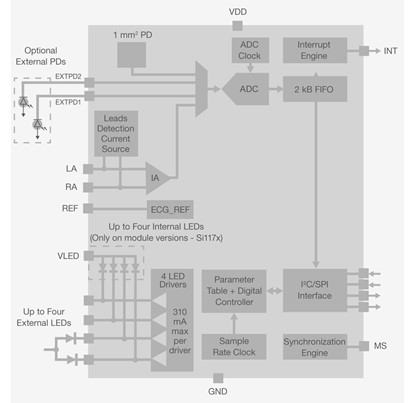
Biometric sensors that focus on power consumption without sacrificing performance
Silicon Labs is already well recognized in the industry for its development of intelligent sensors, including PPG-based biometric sensors that focus on power consumption without sacrificing performance and range from integrated modules to individual sensor products, providing a series of ease of use and design flexibility products for optical heart rate (HR) monitoring and electrocardiogram (ECG) in various wearable applications. Silicon Labs' solutions range from individual sensor products with first-class power and performance to complete monitoring solutions combining integrated modules with LED, photodiode and analog front-end, to algorithms and wireless MCU for transmitting heart rate information via Bluetooth. Using Silicon Labs’ sensors will consume less power and achieve higher accuracy. At the same time, the design will be simplified through heart rate monitoring solutions, and the time-to-market will be shortened through Silicon Labs’ system-level integration and advanced feature sets.
The Si117x module, introduced by Silicon Labs, combines the industry's lowest power optical heart rate solution and best-in-class power. The small integrated module supports up to four different LEDs (all LEDs can be driven at the same time) and simplifies the optical design. Si1172 and Si1173 products can also perform single-channel ECG measurement alongside optical heart rate. You can add additional value and gather more physiological information from users, and can be applied to sports watches, ear-based heart rate management devices, fitness bands and other products.
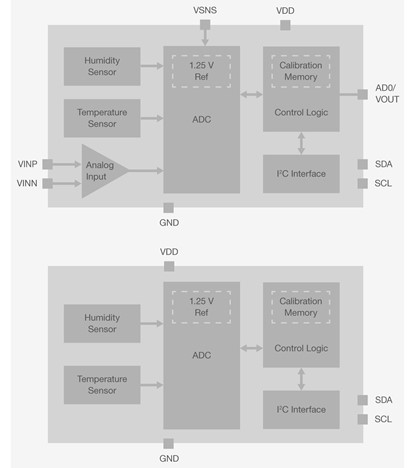
Completely factory calibrated temperature and humidity sensors
Silicon Labs has also launched a series of temperature and humidity sensor solutions for the needs of industry and the Internet of Things. The Si70xx(Si7013/20/21/34) single-chip relative humidity and temperature sensors are designed with the most advanced and innovative technology after verification, which can provide the lowest power consumption for the relative humidity and temperature sensors in the industry, and uses the patented industry standard low-K polymer dielectric, and CMOS mixed-signal integrated circuit for humidity measurement, offering excellent accuracy and long-term stability, as well as low drift and low hysteresis. They are designed for high-precision applications, while Si7006 is intended for low-precision applications that traditionally use discrete humidity/temperature sensors.
These temperature and humidity sensors are fully factory calibrated, and no additional humidity/temperature calibration is required for all Si70xx devices during PCB assembly. Second generation Si7006/13/20/21 devices are combined with an analog-to-digital converter, signal processing and I2C host interface, and are available in 3x3mm package and with a wide power supply voltage of 1.9-3.6 V, while the third-generation Si7034 device is available in smaller 2x2mm packaging and with a low power supply voltage of 1.67-1.98 V. It can be applied to wearable devices and consumer devices, such as asset tracking, industrial monitoring, and Internet of Things nodes.
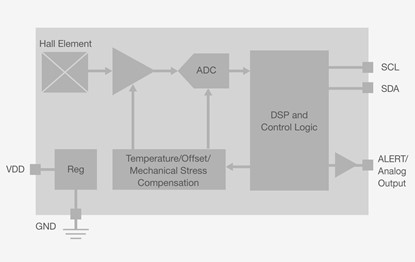
Magnetic sensor with low power consumption and high sensitivity
Hall effect magnetic sensors introduced by Silicon Labs can focus on object detection and position sensing with low power consumption and high sensitivity. These various magnetic sensors have best-in-class power and sensitivity, which can prolong battery life, increase range, and reduce magnet size and cost. Silicon Labs' solution includes a number of advanced features, including I2C configurability, tamper detection, and built-in temperature sensing.
The Si7210 Hall effect magnetic sensor allows you to control and configure devices and read magnetic field data through I2C as required. It has a configurable digital output and allows the host to be interrupted when specified events occur. It is an ideal substitute for switch/latch and linear output magnetic sensors. The Si7210 magnetic sensor has 100 nA sleep power consumption and ultra-low power consumption of 400 nA per second for 5 samples. It can configure devices, access data and wake up/sleep through I2C, has high linearity of 0.1%, and low noise of <30μT RMS, has a built-in 1℃ precision temperature sensor, can generate test magnetic field through a built-in coil, and provides unipolar/omnipolar switch and latch output. It can operate under the power supply range of 1.71-5.5 V. It also provides 0-70℃ and -40-+125 ℃ variant products, supporting the industry standard SOT23 and ultra-thin 0.37mm DFN8 package, and can be applied to door and window sensors, battery detection and position sensing.
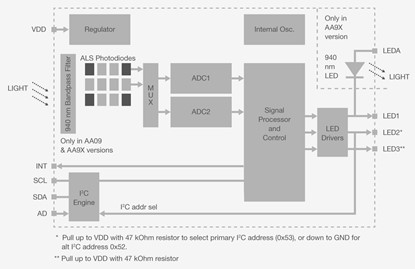
Infrared-based optical sensor with excellent performance
The optical sensor, introduced by Silicon Labs, is based on infrared, suitable for object detection and personnel proximity detection, and can sense ultraviolet index, ambient light, long range proximity, heart rate/pulse oximetry and 2D or 3D gesture motion sensing.
Silicon Labs' Si115x solution is an ambient light sensor, proximity, and gesture detector with an I2C digital interface and programmable event interrupt output. The SI115X sensor includes dual 23-bit analog-to-digital converters, an integrated highly sensitive array of visible and infrared photodiodes, a digital signal processor, and up to three integrated LED drivers with programmable drive levels.
The Si115X provides excellent performance in a wide dynamic range and under various light sources (including direct sunlight). The Si115X sensor can also work under a dark glass cover. The photodiode response and associated digital conversion circuits are immune to artificial light flicker noise and natural light flutter noise. The Si115X sensor has two or more LEDs, which can support multi-axis proximity motion detection and can be applied to thermostats, door and window sensors and daylight harvesting nodes.
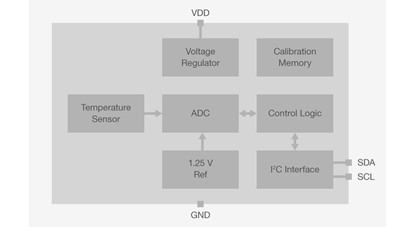
Configurable temperature sensor with high performance
Silicon Labs' temperature sensors focus on high performance and configurability through I²C-based and size optimized package, providing a wide range of accuracy from ±0.1 to ±1℃, with industry-leading power consumption, which can extend the battery life of the system. These sensors operate at frequencies up to 400 kHz via an industry-standard I2C interface and are available in small 2x2 mm or 3x3 mm packages.
Silicon Labs’ Si705x digital temperature sensors deliver industry-leading low power and high precision over the full operating voltage and temperature range. These monolithic CMOS ICs feature band-gap temperature sensor assemblies, analog-to-digital converters with up to 14-bit resolution, signal processing, calibration data, and I2C interfaces. Using new signal processing and analog design patents, the sensors can maintain their precision in a wide temperature and voltage range while consuming very little current.
The Si705x sensor is fully factory calibrated and packaged in 3x3 mm DFN. It only needs an average current of 195nA to sample once per second, and only needs a coin cell to run for several years. It can be applied to medical and skin temperature patches, industrial safety monitoring and Internet of Things sensor nodes.
Conclusion
Intelligent sensors have become the best tool for electronic devices to sense the environment. They are widely used in wearable devices and Internet of Things node devices, which accurately sense various human body and environment data and bring infinite convenience to people's lives. The series of intelligent sensors introduced by Silicon Labs have excellent performance and accuracy and will be one of the best choices for related applications.

